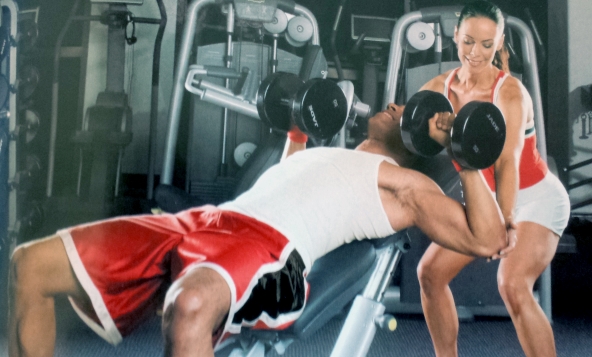
It is always a good idea to have a spotter when exercising particularly with dumbbells, free weights plus it has many other advantages and benefits. However, there are at times when people prefer to work out alone which is fine, but even for them, at times, a spotter can be beneficial and there are always people or personal trainers at the gym who can spare a few minutes to help out. The only drawback is that the spotting may not come from a person who is familiar with your workout or with whom you are comfortable with.
When do you need someone to spot you?
Often when exercising with dumbbells or barbells, particularly for chest and shoulders, there are times when you may have trouble getting the weights to the starting position to begin a set or to complete the final repetition. Once you get them to the starting position, you can continue with your exercise by yourself. In these cases you need someone to help you push the dumbbells or lift the bar to the starting position.
If a person is using dumbbells you want to be behind the person and gently, but firmly aid the person. Place the palm of your hands on either side that is, below the person’s arms just above the elbow and under the triceps. You don't want to put your hands right under the elbows becasue this doesn't give you the proper leverage to aid the person. This motion will aid in moving the dumbbells to the starting position depending on the type of exercise that he or she is doing. Similarly, the final few reps of an exercise may be the most difficult. By aiding and helping to move, push the weights up in the same manner, this enables the person to accomplish reps that alone he or she may not be able to do.
If a person is using barbells particularly for the bench chest press (flat, incline or decline) lift the bar from the middle to begin the exercise and get the person to the starting. Again for the final rep or reps you may need to spot the person.
Remember that for the final reps you want to assist the person in a firm way without you doing all the lifting or pushing up and thus depriving the person of the workout benefits. It’s only when the person absolutely cannot do or complete the final rep that you should and would use more effort and force as a precautionary measure.
So basically a spotter in these cases helps to enable difficult reps to be done at the same time as providing a safety factor during the workout. Also, some of the newer benches at gyms tend to be a little wobbly or not fit your physique adequately, so by having a spotter, they can provide you with more reassurance and stability in your workout.
If you prefer not to use a spotter and like to work out yourself, the Hammer Strength line of machines using plates are the best option because you have full control over each rep. You can comfortably push yourself to the max without fear of not being able to complete the final rep or endangering yourself. The same is true when using cable operated machines with stacked plates like the Nautilus, FreeMotion, LifeFitness and Matrix machines. Using these machines, if you absolutely cannot do the final repetition you can even let go without hurting yourself. Not something I would recommend because it damages the machine, but it is a measure of last resort. Even with these machines, sometimes it’s good to have a spotter to push the final repetition that normally you would not be able to do or to begin the first rep. These type of machines provide you with a measure of safety and security when lifting heavy weight by yourself.
The other benefits of using a spotter is that he or she can make sure that you are using proper form and help you get more motivated and encourage you, sort of like a friendly competition between the two of you and a buddy system.
In summary, whether you prefer to work out with someone or not, it is always good at certain times to have someone reliable who can be there to spot you.